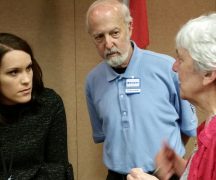Ohio Capital Journal
State Sen. Rob McColley says the goal of new legislation pertaining to wind turbines is not to “thwart” wind energy production in Ohio.
When asked Tuesday about concerns of turbines, though, McColley had several to mention: an alleged negative impact to home values and safety issues for those living near them. He also pointed out a turbine can be several times larger than the Statue of Liberty.
McColley, R-Napoleon, is the main sponsor of Senate Bill 234, which would allow residents of unincorporated townships to approve or reject wind farm projects by referendum ballot. The bill also adjusts the required wind turbine “setbacks” — the distance between the turbine and adjacent property lines.
Currently, the Ohio Power Siting Board is in charge of the wind facility certification process for projects with a generating capacity of at least 5 megawatts. McColley wants to let residents decide rather than solely the “unelected bureaucrats” on the Siting Board.
By law, the Siting Board is composed of numerous state agency leaders, such as Ohio Department of Agriculture Director Dorothy Pelanda and Public Utilities Commission of Ohio (PUCO) Chairman Sam Randazzo. Four state legislators serve on the board in non-voting capacities.
McColley represents all or parts of 11 rural counties in Northwest Ohio. His district includes most of Ohio’s existing wind production. There are more than 300 turbines operating in Van Wert, Paulding and Hardin counties with a capacity of around 670 megawatts.
There are other Siting Board-approved projects under construction near Kenton (about 55 miles northwest of Columbus) and Greenwich (a village about 20 miles north of Mansfield).
Further, a few other projects such as the proposed Emerson Creek Wind Farm are still being considered. There has been local opposition to that project, including from township trustees and residents alike, with some donning yellow t-shirts reading “No Wind Turbines Erie-Huron Counties” at various meetings related to the Emerson Creek project. A few traveled to Columbus for Tuesday’s first hearing on SB 234 in front of the Energy and Public Utilities Committee.

These are the voices McColley and eight Republican co-sponsors want to be involved in the wind farm approval process going forward. Among the co-sponsors is Nathan Manning, R-North Ridgeville, whose district includes most of the coverage area for Emerson Creek as well as the Greenwich project. The remaining co-sponsors are also from primarily rural districts throughout the state.
Under SB 234, the Siting Board would still be responsible for issuing a project certification for large-scale wind farm projects. However, the certification would not go into effect for another 90 days, thus giving local residents enough time to file a referendum petition to their county’s board of elections. Voters in an unincorporated township area would have a chance to approve or reject new projects, as well as “amendments” to existing wind farms — such as adding more turbines, moving them or increasing their height.
In the case of a project being located in multiple townships, their respective voters could decide upon separate referendums. Should only one of the multiple ballot items pass, the Siting Board would modify the operating certificate to exclude the area covering the rejecting township.
The bill would also regulate the distance from adjacent properties (the “setback”). The horizontal distance must be at least one-and-one-tenth times its height, though it may be even further away if the turbine’s manufacturer recommends so.
McColley said there are concerns about turbine safety and referenced the potential of “blade shear.” The Siting Board requires wind farm applicants conduct risk evaluations for “ice throw” and “blade shear” prior to a certificate being approved.
He also claimed single-family home values in Van Wert County are lower in townships with turbines than in areas without.
McColley acknowledged the positive impacts of wind farms, such as providing more school funding to rural districts. He added, though, that letting money control the process would be akin to “the tail wagging the dog.”


